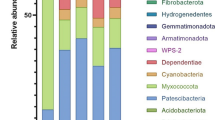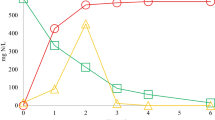Abstract
This study characterized the microbial community and population dynamics in an anaerobic hybrid reactor (AHR) treating cassava starch wastewater. Methanogens and nonmethanogens were followed during the start-up and operation of the reactor, and linked to operational and performance data. Biomass samples taken from the sludge bed and packed bed zones of the AHR at intervals throughout the operational period were examined by 16S rRNA fluorescence in situ hybridization (FISH). The start-up seed and the reactor biomass were sampled during the feeding of the wastewater with a chemical oxygen demand (COD) value of 8 g L−1 and a hydraulic retention time (HRT) of 8 days. These samples were characterized by the predominance of cells with long-rod morphology similar to Methanosaeta spp. Following a sharp operational change, accomplished by increasing the COD concentration of the organic influent from 8 to 10 g L−1 and reducing the HRT from 8 to 5 days, there was a doubling of the organic loading rate, a reduction of the COD removal efficiency, as well as decreased methane content in the biogas and an accumulation of total volatile acids in the reactor. Moreover, this operational change resulted in a significant population shift from long-rod Methanosaeta-like cells to tetrad-forming Methanosarcina-like cells. The distributions of microbial populations involved in different zones of the AHR were determined. The results showed that nonmethanogens became the predominant population in both sludge and the packed bed zone. However, the percentage of methanogens in the packed bed zone was higher than that in the sludge bed zone. This higher percentage of methanogens was likely caused by the fact that the packed bed zone provided a suitable environmental condition with an appropriate nutrient availability for methanogen growth.





Similar content being viewed by others
References
Amann, R, Ludwig, W, Schleifer, KH (1995) Phylogenetic identification and in situ detection of individual microbial cells without cultivation. Microbiol Rev 59: 143–169
Amann, RI, Krumholz, L, Stahl, DA (1990) Fluorescent-oligonucleotide probing of whole cells for determinative, phylogenetic, and environmental studies in microbiology. J Bacteriol 172: 762–770
Amann, RI, Stromley, J, Devereux, R, Key, R, Stahl, DA (1992) Molecular and microscopic identification of sulfate-reducing bacteria in multispecies biofilms. Appl Environ Microbiol 58: 614–623
APHA (1995) Standard Method for Examination of Water and Wastewater, 19th ed. APHA/AWWA/WPCF, Washington, DC
Araujo, JC, Brucha, G, Campos, JR, Vazoller, RF (2000) Monitoring the development of anaerobic biofilms using fluorescent in situ hybridization and confocal laser scanning microscopy. Water Sci Technol 41: 69–77
Borja, R, Banks, CJ, Wang, Z (1995) Performance of a hybrid anaerobic reactor, combining a sludge blanket and a filter treating slaughterhouse wastewater. Appl Microbiol Biotechnol 43: 351–357
Chaiprasert, P, Suvajittanont, W, Suraraksa, B, Tanticharoen, M, Bhumiratana, S (2003) Nylon fibers as supporting media in anaerobic hybrid reactors: it’s effects on system’s performance and microbial distribution. Water Res 37: 4605–4612
Chung, YC, Choi, YS (1993) Microbial activity and performance of an anaerobic reactor combining a filter and a sludge bed. Water Sci Technol 27: 187–194
Fannin, KF (1987) Start-up, operation, stability and control. In: Chynoweth, DP, Isaacson, R (Eds.) Anaerobic Digestion of Biomass, Elsevier, London, UK, pp 171–196
Gonzalez-Gil, G, Lens, PNL, Van Aelst, A, Van As, H, Versprille, AI, Lettinga, G (2001) Cluster Structure of anaerobic aggregates of an expanded granular sludge bed reactor. Appl Environ Microbiol 67: 3683–3691
Grotenhuis, JT, Smit, CM, Plugge, CM, Yuansheng, W, Van Lammeran, AAM, Stams, AJM, Zehnder, AJB (1991) Bacteriological composition and structure of granular sludge adapted to different substrates. Appl Environ Microbiol 57: 1942–1949
Jetten, MSM, Stams, AJM, Zehnder, AJB (1992) Methanogenesis from acetate: a comparison of the acetate metabolism in Methanothrix soehngenii and Methanosarcina spp. FEMS Microbiol Rev 88: 181–198
Jupraputtasri, W, Boonapatcharoen, N, Cheevadhanarak, S, Chaiprasert, P, Tanticharoen, M, Techkarnjanaruk, S (2005) Use of an alternative Archaea-specific probe for methanogen detection. J Microbiol Methods 61: 95–104
Leclerc, M, Delgenes, JP, Godon, JJ (2004) Diversity of the archaeal community in 44 anaerobic digesters as determined by single strand conformation polymorphism analysis and 16S rDNA sequencing. Environ Microbiol 6: 809–819
Lettinga, G (1995) Anaerobic digestion and wastewater treatment systems. Antonie Van Leeuwenhoek 67: 3–28
Lui, WT, Chan, O-C, Fang, HHP (2002) Characterization of microbial community in granular sludge treating brewery wastewater. Water Res 36: 1767–1775
Manz, W, Eisenbrecher, M, Neu, TR, Szewzyk, U (1998) Abundance and spatial organization of Gram-negative sulfate-reducing bacteria in activated sludge investigated by in situ probing with specific 16S rRNA targeted oligonucleotides. FEMS Microbiol Ecol 25: 43–61
Manz, W, Wagner, M, Amann, R, Schleifer, K-H (1994) In situ characterization of the microbial consortia active in two wastewater treatment plants. Water Res 28: 1715–1723
McMahon, KD, Stroot, PG, Mackie, RI, Raskin, L (2001) Anaerobic codigestion of municipal solid waste and biosolids under various mixing conditions—II: microbial population dynamics. Water Res 35: 1817–1827
Merkel, W, Manz, W, Szewzyk, U, Krauth, K (1999) Population dynamics in anaerobic wastewater reactors: modeling and in situ characterization. Water Res 33: 2392–2402
Oleszkiewicz, JA, Thadani, VJ (1988) Effect of biofilter media on the performance of anaerobic hybrid reactor. Environ Technol Lett 9: 89–100
Oude Elferink, SJWH, Visser, A, Hulshoff Pol, LW, Stams, AJM (1994) Sulphate reduction in methanogenic bioreactors. FEMS Microbiol Rev 15: 119–136
Ouverney, CC, Fuhrman, JA (1997) Increase in fluorescence intensity of 16S rRNA in situ hybridization in natural samples treated with chloramphenicol. Appl Environ Microbiol 63: 2735–2740
Rabus, R, Fukui, M, Wilkes, H, Widdle, F (1996) Degradative capacities and 16S rRNA-targeted whole cell hybridization of sulfate-reducing bacteria in anaerobic enrichment culture utilizing alkylbenzenes from crude oil. Appl Environ Microbiol 62: 3605–3613
Raposo, F, Borja, R, Sanchez, E, Martin, MA, Martin, A (2004) Performance and kinetic evaluation of the anaerobic digestion of two-phase olive mill effluents in reactors with suspended and immobilized biomass. Water Res 38: 2017–2026
Raskin, L, Amann, RI, Poulsen, LK, Rittmann, BE, Stahl, DA (1995) Use of ribosomal RNA-based molecular probes for characterization of complex microbial communities in anaerobic biofilm. Water Sci Technol 31: 261–272
Raskin, L, Rittmann, BE, Stahl, DA (1996) Competition and coexistence of sulfate-reducing and methanogenic populations in anaerobic biofilms. Appl Environ Microbiol 62: 3847–3857
Raskin, L, Stromley, JM, Rittmann, BE, Stahl, DA (1994) Group-specific 16S rRNA hybridization probes to describe natural communities of methanogens. Appl Environ Microbiol 60: 1232–1240
Sekiguchi, Y, Kamagata, Y, Nakamura, K, Ohashi, A, Harada, H (1999) Fluorescence in situ hybridization using 16S rRNA-targeted oligonucleotides reveals localization of methanogens and selected unclutured bacteria in mesophilic and thermophilic sludge granules. Appl Environ Microbiol 65: 1280–1288
Sekiguchi, Y, Kamagata, Y, Syutsubo, K, Ohaashi, A, Harada, H, Nakamura, K (1998) Phylogenetic diversity of mesophilic and thermophilic granular sludges determined by 16S rRNA gene analysis. Microbiology 144: 2655–2665
Stahl, DA, Amann, RI (1991) Development and application of nucleic acid probes. In: Stackbrandt, E, Goodfellow, M (Eds.) Nucleic Acid Techniques in Bacterial Systematics, John Wiley & Sons, Inc., New York, pp 205–248
Zinder, SH (1993) Physiological ecology of methanogens. In: Ferry, JG (Ed.) Methanogenesis: Ecology, Physiology, Biochemistry and Genetics, Chapman & Hall, New York, pp 128–206
Acknowledgments
This study was supported by a research grant from the National Center for Genetics Engineering and Biotechnology (BIOTEC), Thailand. Nimaradee Boonapatcharoen and Kulyanee Meepian were supported by postgraduate scholarships from BIOTEC.
Author information
Authors and Affiliations
Corresponding author
Rights and permissions
About this article
Cite this article
Boonapatcharoen, N., Meepian, K., Chaiprasert, P. et al. Molecular Monitoring of Microbial Population Dynamics During Operational Periods of Anaerobic Hybrid Reactor Treating Cassava Starch Wastewater. Microb Ecol 54, 21–30 (2007). https://doi.org/10.1007/s00248-006-9161-6
Received:
Revised:
Accepted:
Published:
Issue Date:
DOI: https://doi.org/10.1007/s00248-006-9161-6




